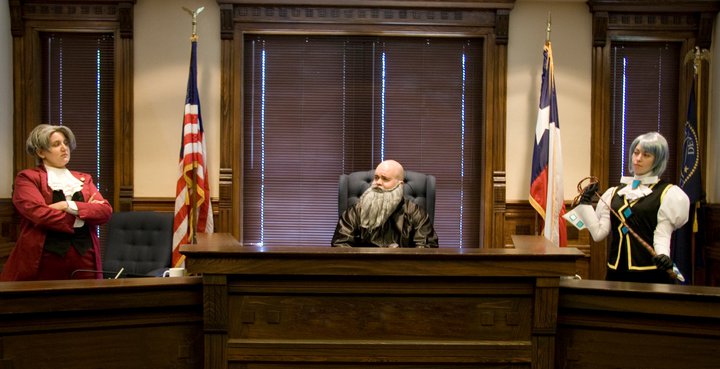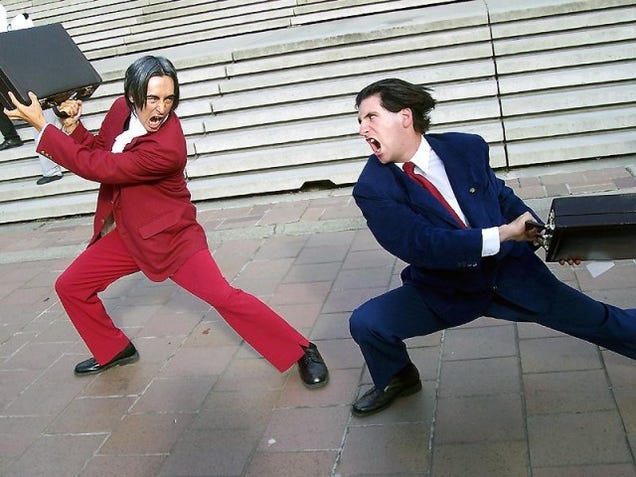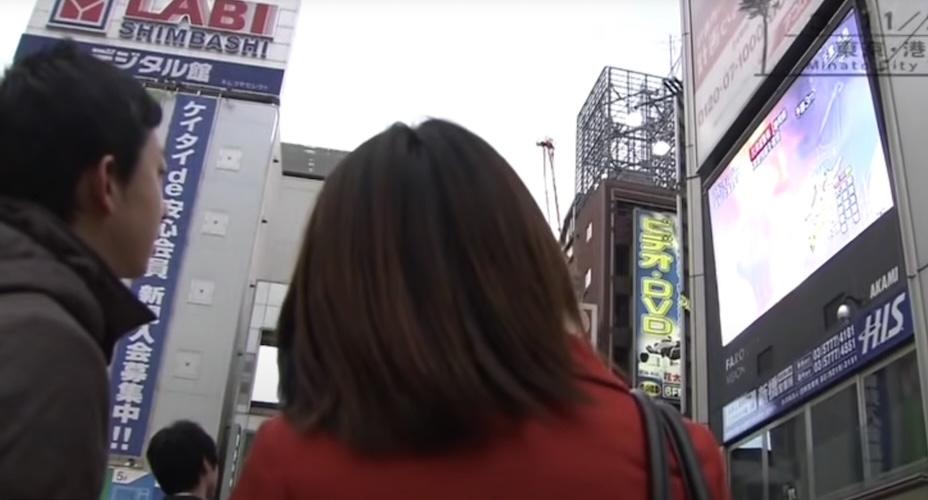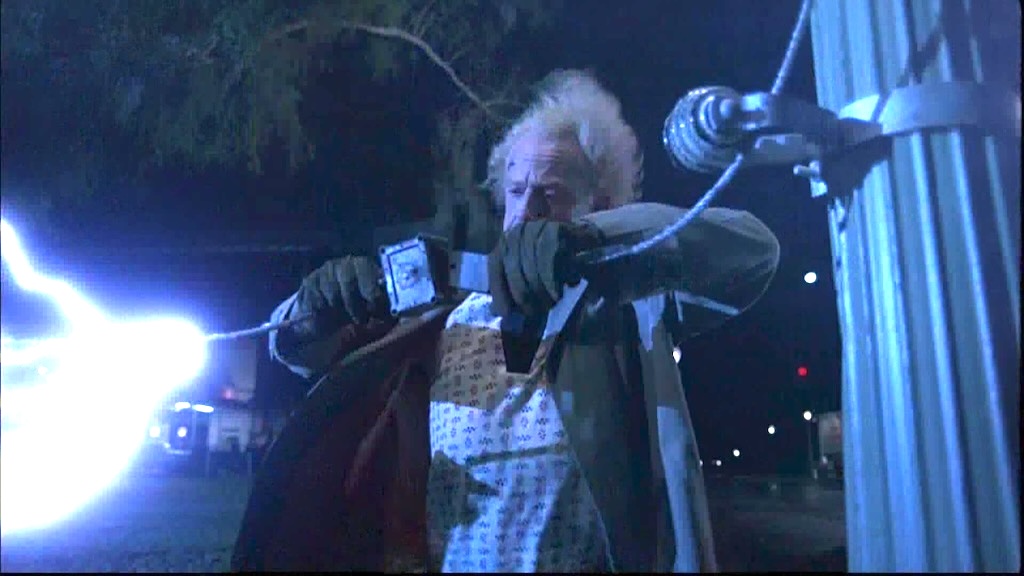Dictation testing involving cross-examination of a witness by lawyers in a courtroom is known colloquially in the court reporting profession as “Q&A” (Question and Answer).
With Plover open source stenography, you can cosplay as a court reporter, show off your ability to track the communication threads of multiple participants in a courtroom conversation, and present them in official-looking transcripts of testimony.
So, put on your power suit and pack your briefcase, cause we’re going to go and act like we belong in the halls of justice!
Caveat Lector
I am not a lawyer, a court reporter, nor involved in the legal profession whatsoever. I am just a stenography enthusiast who learned about the concept of Q&A while studying Platinum Steno’s (PS) video theory lessons (more about that in my other blog post, Going Platinum), and what is presented here is just my interpretation of what I discovered. Consequently, there is definitely a chance that I have gotten some things wrong, and if I have, please reach out via public comment below, or to me directly.
Plover theory itself does not contain any outlines related to Q&A like the ones that would seem to be contained in PS’s custom software, and are taught in their Q&A lessons. So, in order to actively engage in those lessons, I wondered if I could attempt to recreate PS’s Q&A outline entries (including their formatting conventions and rules, which may be specific to them, and differ between courts in different hierarchies/states/jurisdictions/countries etc) in a custom dictionary that would work with Plover.
I think I was able to, and have presented the result pro bono publico in the form of:
Feel free to incorporate it into your own Plover dictionaries and give the Q&A lessons a shot, or just use it to follow along with the examples in this post!
Armed with a dictionary to use, let’s learn how to use it, while getting an introduction to Q&A itself!
UPDATE 22 February 2024: If you don’t want to maintain another dictionary, I have packaged up all the Q&A logic in this post (and more) into a Plover plugin called Plover Q&A. You can find it in the Plugins Manager of your Plover application.
Ab Initio
There are, broadly, two different types of Q&A testing:
- 2-Voice: an interrogative conversation between two participants: a lawyer and a witness. The lawyer can be either for the plaintiff/prosecution, or for the defense, but this detail is usually not relevant to the scope of the conversation.
- 4-Voice: a cross-examination involving lawyers from each opposing party, a witness, and the courtroom judge. Handling multiple lawyers in either party is possible, so it can technically be “4-to-6-Voice”, but there are typically only four participants.
2-Voice transcripts typically read like a simple back-and-forth question and answer session, while 4-Voice builds on this by including added complexity like:
- marking a lawyer’s “ownership” of a line of questioning
- transcribing objections raised by lawyers, and subsequent guidance by the judge
- specific transcribing conventions for when interruptions occur during a lawyer’s line of questioning, causing it to veer off its original path, and then the subsequent “steering” of the record back to original line of questioning once the detour has ended
We will start off with a deep dive into using Plover for 2-Voice, and then up ante with 4-Voice.
2-Voice

During Q&A, whenever someone starts speaking, you indicate this by “signing them in”, either by name, or marking them as the asker or answerer of a question.
For 2-Voice, names are not important, and we only care about marking the question and its answer. Questioners and answerers are “signed in” using special outlines known as question and answer “banks”, which PS defines as follows:
| Stroke | Outline | Keymap |
|---|---|---|
| Question Bank | STKPWHR | STKPWHR |
| Answer Bank | -FRPBLGTS | -FRPBLGTS |
These outlines, like nearly all Q&A-related outlines, are not meant to be phonetic (indicative of how the word sounds), nor orthographic (indicative of how the word is spelled). So, I find it easiest to remember their form, or pattern, kind of like Tetris blocks. Hence, I would wager the rectangular chunks here are meant to evoke an image of land masses along the side of the middle *-key river that divides them.
Using these outlines, a simple question and answer could display as something like the following:
Q Where were you on the night of January 16?
A I was at home, practicing steno.
This formatting obeys the following rules:
- Questions are marked with a simple “Q”, and answers with an “A” (no following colons or periods)
- Q and A have a tab character on either side of them
- Both questions and answers start with capital letters
Court transcripts would seem to be written using a monospaced font, so we will adopt that convention as well, using the widely-available Courier New font.
Ending Punctuation
The one thing that is not apparent just by looking at the example above is the convention around a speaker’s final sentence punctuation before another speaker starts talking.
Apparently, in Q&A, the addition of an ending question mark (?) or period (.) to the final sentence spoken before the speaker changes is meant to be handled by the outline that signs in the next speaker.
For example, when you switch from a question to an answer by stroking -FRPBLGTS, that outline is expected to:
- Finish the question with a “?”
- Perform a line break
- insert a tab
- type A
- insert another tab
- make sure the next word will start with a capital letter
The rule is the same when switching from an answer back to a question, but with an ending “.” and a beginning Q.
Regarding this ending punctuation rule, PS says that the (presumably custom) software they use on their steno machines makes some kind of automatic determination about whether a question was asked or an answer given, and adds in appropriate question/answer punctuation as it deems appropriate.
PS does say that this determination is not perfect, and hence you may end up with question marks at the end of answers, or periods that the end of questions (which may be correct for the sentence sometimes since lawyers can make statements, and witnesses can ask questions). The workaround to this issue, it would seem, is to just fix the punctuation post-hoc when you proofread your transcript.
Plover itself has no built-in knowledge of any kind of “Q&A-related ending punctuation automatic determination functionality”, so I attempted to mostly replicate the PS software logic into my custom Q&A dictionary, but also make a few quality-of-life improvements. The aim was to provide sensible defaults for ending punctuation, but also allow for manual overriding for when you want to explicitly specify what they should be.
With that in mind, here is a set of outlines I came up with to perform 2-Voice in a more flexible way:
| Stroke | Outline | Keymap | Notes |
|---|---|---|---|
| Default Question Bank | STKPWHR | STKPWHR | Ends previous witness sentence with "." |
| Initial Question Bank | STKPWHR* | STKPWHR* | Question is the first line of transcript; no previous sentence punctuation needed. |
| Question Bank following question | STKPWHR-F | STKPWHR-F | Ends previous witness sentence with "?", for when witness asks a question. |
| Interrupting Question Bank | STKPWHR-RB | STKPWHR-RB | Ends previous witness sentence with "--" for when lawyer interrupts witness. |
| Question Bank following statement | STKPWHR-R | STKPWHR-R | Ends previous witness sentence with "." (same as Default Question Bank, added for completeness' sake) |
| Default Answer Bank | -FRPBLGTS | -FRPBLGTS | Ends previous lawyer sentence with "?" |
| Answer Bank following statement | R-FRPBLGTS | R-FRPBLGTS | Ends previous sentence with ".", for when lawyer makes a statement. |
| Interrupting Answer Bank | WR-FRPBLGTS | WR-FRPBLGTS | Ends previous sentence with "--" for when witness interrupts lawyer. |
| Answer Bank following question | H-FRPBLGTS | H-FRPBLGTS | Ends previous sentence with "?" (same as Default Answer Bank, added for completeness' sake) |
Some further notes on this set of outlines:
- In Q&A, sentences would seem to only ever end in question marks, periods, or dashes. No exclamation marks, or any other type of punctuation, would seem to be used, so I did not create any outlines using them
- I chose the
H-and-Fkeys to delineate ending questions since they are on the higher steno row, indicating the typical upward voice inflection of a spoken question, and vice versa for theR-and-Rkeys for statements - I chose
-RBfor an ending dash as it marks the “sh” sound in the Plover “dash” outline (TK-RB), and use ofWR-is just a mirror reflection of that - No Initial Answer Bank outline was created since it would seem that there are never answers given without a question in Q&A
-
If you are following along with my custom Q&A dictionary, you may notice that tabs and newline characters in the entries use the special
\tand\ncharacters, rather than Plover keyboard shortcuts like{#tab}and{#return}. For example, the entry for the Default Question Bank:"STKPWHR": "{.}{^\n\t^}{^Q^}{^\t^}{-|}"This is done simply to enable undoing the entire entry in one keystroke. Using Plover keyboard shortcuts makes what the
*key can undo significantly less predictable.More details about the reasons behind this can be found in Plover’s documentation on Undoable Line Breaks and Tabs, and more details about all those other characters in the entry can be found in Plover’s Dictionary Format documentation.
2-Voice Demos
In order to show my Q&A dictionary in action, I have recorded a few videos of myself attempting to transcribe some of PS’s initial Q&A lessons. Don’t expect stellar steno speeds (or much competence at all) in the videos below as I am still learning ![]()
The letters on the light board behind the instructor indicate who is currently speaking:
- P: Plaintiff/Prosecution
- W: Witness
- C: The Court (the Judge)
- D: Defense
There will be more variation in these lights once we get into 4-Voice.
The following video is of PS’s very first Q&A lesson, so the conversation is quite straightforward and slow. One thing to note, though, is that it begins with the questioner making a statement, necessitating use of the R-FRPBLGTS outline.
See Appendix A: Formatting the Record for how I set up Google Docs to produce official-looking(?) court transcripts.
This next video is more of the same, but note that when the witness is asked to spell their name, a technique called “stitching” is used. As apposed to fingerspelling, stitching deliberately separates letters with dashes to indicate that a speaker is verbally spelling out a word letter by letter.
See Appendix B: Stitching for more about stitching, and the custom dictionary I created for it.
In the next video, note the use of the STKPWHR-F outline when the witness asks the lawyer a question, and R-FRPBLGTS for when the lawyer answers.
In the final 2-Voice demo, note the use of the STKPWHR-RB outline when the lawyer interrupts the witness.
Now that we have gotten the general rules of questioning and answering down, it is time to up the ante and introduce more dramatis personae to the conversation.
4-Voice

Courtroom cross-examination of a witness involves more than just a single legal team, but also the opposing side’s legal team, and the court itself. We are now beyond being able to sign in a speaker with just Q and A: we need to give the speakers names.
So, let’s introduce the expanded cast of characters in our courtroom drama with their designated outlines:
| Person | Outline | Keymap | Output | Notes |
|---|---|---|---|---|
| Plaintiff Lawyer 1 | STPHAO | STPHAO | MR. STPHAO | Known as "Mr. Snoo" |
| Plaintiff Lawyer 2 | SKWRAO | SKWRAO | MR. SKWRAO | Known as "Mr. Screw" |
| The Court | STPHAOEUFPLT | STPHAOEUFPLT | THE COURT | |
| Defense Lawyer 1 | EUFPLT | EUFPLT | MR. EUFPLT | Known as "Mr. Ifpelt" |
| Defense Lawyer 2 | EURBGS | EURBGS | MR. EURBGS | Known as "Mr. Irbs" |
| Witness | W-PBS/W-PBS | W-PBS W-PBS | THE WITNESS | This is PS's designated outline |
| Witness | SKWRAOEURBGS | SKWRAOEURBGS | THE WITNESS | This is my personal alternative outline |
Some further notes on this set of outlines:
- The pronounced “names” for each of the lawyers (“Mr. Snoo” etc) come from PS, and would seem to indicate the colloquial way they are referred to based on the literal steno pronunciation of the outline
- In Q&A, it is apparently rare to have multiple lawyers on any legal team, so you will mostly be using “Mr. Snoo” and “Mr. Ifpelt”, but the full set of outlines is included in the custom Q&A dictionary for completeness’ sake
- Since lawyers are humans, and humans typically have names that are not MR. STPHAO, the output of the lawyer outlines can be considered placeholders. Before a Q&A exercise starts, if you are given the lawyer names, you can just do a simple text find-and-replace in the Q&A dictionary to change MR. STPHAO to MS. WEXLER etc where appropriate. The outlines for the judge and witness are never given specific names
- The formatting for the output of all of these outlines is uppercase. What is not shown above, but will be shown in an extract below, is that a tab is output before the name, and then a colon and a space is output following the name
- Plover theory has already assigned the word “irks” to Defense Lawyer 2’s
EURBGSoutline. So, Caveat Utilitor that if you use the Q&A outline, you will be mildly inconvenienced by needing to stroke the word “irks” asEURBG/-SorEURBG/-Z - PS’s witness outline of
W-PBS/W-PBSfelt a bit awkward to me, given the shapes of the other outlines, and having to stroke the same outline twice. The “lower row version” of The Court outline,SKWRAOEURBGS, was not assigned to anything in Plover, so it made sense to me to assign it to the witness: the judge sits on the “high” bench, and the witness sits in the “low” dock. Both sets of outlines are included in the custom Q&A dictionary, so feel free to use whichever outline works for you - Like the question and answer bank outlines, each outlines above comes with a set of variations that marks it as the first line of the transcript, or ends the previous sentence with a period, question mark, or dash. Check out the custom dictionary itself for all those details
This is quite a lot to take in, so let’s have a look at an example that uses the new outlines above, the question/answer ones we have already seen, and one we will have a look at later:
BY MR. CHAMBERS:
Q All right. Miss Smith, where do you currently live?
A 1892 Spring Drive in Riverside.
Q Did you live at that address in July of 2018?
A Yes, sir.
MR. DUGO: Your Honor, I am having a difficult time hearing the witness.
THE COURT: Miss Smith, I know it is tough, but have got to keep your voice up a little bit. It is hard to hear in this courtroom, okay?
THE WITNESS: Yes, your Honor.
- The first line, BY MR. CHAMBERS, is a byline, and indicates that the lawyer Mr. Chambers is in charge of, or owns, the current line of questioning: his questions are marked by Q and the witness’s answers are marked by A. We will look more at bylines next up
- The next few lines are standard Q&A that we have seen before, which use the question and answer bank outlines
- On line 6, the opposing lawyer, Mr. Dugo, interrupts the line of questioning. Mr. Dugo does not own the line of questioning, so he does not get a byline, but instead his statement is recorded inline. From this point, we have veered off the current line of questioning
- On line 7, the judge addresses the witness, with the question also recorded inline
- On line 8, the witness answers the question. An answer sign-in using A only occurs when the witness answers a question posed by the lawyer who owns the current line of questioning. Since the witness is answering the judge’s question, and not a question posed by Mr. Chambers, it is recorded inline as THE WITNESS. Whenever a witness talks out of turn without being asked a question, or is not directing an answer at the lawyer who owns the line of questioning (like at the judge here, or at the opposing lawyer), witness statements are recorded in this way
Bylines

Bylines are used to indicate the lawyer that owns, or is in charge of, the current line of questioning to a witness. The outline that signs in a lawyer outputs in the following format:
BY <TITLE>. <SURNAME>:
Q <cursor>
It would seem that the convention is to output the lawyer’s title and surname, all in capital letters, and then output a question bank to kick off cross-examination. Like specific naming in outlines mentioned earlier, witnesses and judges also do not get bylines.
Whenever the lawyer begins questioning, they are signed in with a byline. If they finish questioning, and a lawyer from the opposing legal team begins questioning, they are signed in separately. If, as you saw in the transcript above, a line of questioning is interrupted, when it re-begins again, the same lawyer gets re-signed in.
Here is a set of outlines that can be used for the bylines of Plaintiff Lawyer 1 and Defense Lawyer 1 (check the custom Q&A dictionary for details of the other lawyers, but they follow the same pattern):
| Stroke | Outline | Keymap | Notes |
|---|---|---|---|
| Plaintiff Lawyer 1 Initial Byline | STPHAO* | STPHAO* | Byline is the first line of transcript; no previous sentence punctuation needed. |
| Plaintiff Lawyer 1 Byline following question | STPHAO*F | STPHAO*F | Ends previous sentence with "?" |
| Plaintiff Lawyer 1 Byline following statement | STPHAO*R | STPHAO*R | Ends previous sentence with "." |
| Plaintiff Lawyer 1 Byline following interruption | STPHAO*RB | STPHAO*RB | Ends previous sentence with "--" |
| Defense Lawyer 1 Initial Byline | *EUFPLT | *EUFPLT | Byline is the first line of transcript; no previous sentence punctuation needed. |
| Defense Lawyer 1 Byline following question | H*EUFPLT | H*EUFPLT | Ends previous sentence with "?" |
| Defense Lawyer 1 Byline following statement | R*EUFPLT | R*EUFPLT | Ends previous sentence with "." |
| Defense Lawyer 1 Byline following interruption | WR*EUFPLT | WR*EUFPLT | Ends previous sentence with "--" |
4-Voice Demos
Now that you have been formally introduced to the cast of characters in our courtroom drama, and how they interact with each other, let’s see how that all plays out in some video demos.
The first demo shows a basic 4-Voice example using the lawyer name placeholders. Typically, you are given the lawyer names before beginning Q&A so you can substitute them in.
Note the switching of bylines as each lawyer begins and ends their lines of questioning. Also note that when the lawyers indicate that they have no further questions, since that statement is not a question directed at the witness, it is not transcribed with a Q, but as a named statement under their own byline.
The next video is more of the same, but actually using human names for the lawyers.
Adjournment sine die
There is more to learn about Q&A than I have been able to cover here, so if you are interested in delving even deeper, I would highly recommend checking out the following videos specifically from the Platinum Steno Theory playlist:
The entire set of theory lessons is great, but if you want more information specifically on Q&A, then I think these are the main two you want to watch.
Even if you are not planning on becoming a court reporter, I think that doing these kinds of Q&A exercises is great dictation practice in general, and I can see the ability to be able to manage conversation threads being applicable to captioning other kinds of conversational interactions: re-assign the outlines for lawyers, the judge, and the witness to panelists, an adjudicator, and the audience, and you can now transcribe a debate!
If you end up giving it a try, and perhaps improve on the methods outlined here, be sure to reach out!
Wondering where that cool steno keyboard font came from? Go get it from Kathy’s Steno Display Font Github repository!
UPDATE 25 November 2021: Immediate Responses
I am now at the stage where I have completed PS’s 60WPM speed building video list (it only took me five months, and I still do not think I am at 60WPM; the grind continues…), and during the Q&A exercises there were enough repeated scenarios that came up that I felt a few new outlines were in order.
They all revolve around providing immediate output for common responses to a Q or A upon switching speakers.
Witnesses
Some common words and phrases that begin an answer from witnesses are:
- Affirmative statements: “Yes.”, “Yes, sir.”, “Yeah.”, “Correct.”, “Right.”, “Sure.”, “Uh-huh.”
- Negative statements: “No.”, “No, sir.”
- Unsure statements: “I don’t know.”
Being able to immediately output any of these after an A would be really handy.
Notice that all of the examples above are terminated with a period.
According to PS, these initial statements in isolation are considered the answer to a question, with any further statements being extraneous information or just further elaborative context.
So, where you may write “Yes, I did.” in standard English, in a legal transcript, this would instead be “Yes. I did.” (YMMV)
Given the examples above, here is the set of new outlines that I added to my custom Q&A dictionary for use with a witness:
| Stroke | Outline | Keymap | Notes |
|---|---|---|---|
| "Yes." and elaborate | KWR-FRPBLGTS | KWR-FRPBLGTS | Derived from the KWR outline for the letter "Y" for "yes", then the answer bank. |
| "Yes, sir." and elaborate | SKWR-FRPBLGTS | SKWR-FRPBLGTS | Derived from KWR with an inverted S to make YS for "yes, sir", then the answer bank. |
| "Yeah." and elaborate | KWREFRPBLGTS | KWREFRPBLGTS | Derived from Plover's KWR*E outline for "yeah", then the answer bank. |
| "Correct." and elaborate | KR-FRPBLGTS | KR-FRPBLGTS | Derived from Plover's KREBGT outline for "correct", then the answer bank. |
| "Right." and elaborate | TR-FRPBLGTS | TR-FRPBLGTS | Derived from a truncated and inverted version of Plover's RAOEUT outline for "right", then the answer bank. |
| "Sure." and elaborate | SH-FRPBLGTS | SH-FRPBLGTS | Derived from a truncated version of Plover's SHUR outline for "sure", then the answer bank. |
| "Uh-huh." and elaborate | HUFRPBLGTS | HUFRPBLGTS | Awkwardly derived from Plover's *U/H*U outline for "uh-huh", then the answer bank. |
| "No.", and elaborate | TPH-FRPBLGTS | TPH-FRPBLGTS | Derived from the TPH outline for the letter "N" for "no", then the answer bank. |
| "No, sir.", and elaborate | STPH-FRPBLGTS | STPH-FRPBLGTS | Derived from TPH with an inverted S to make NS for "no, sir", then the answer bank. |
| "I don't know.", and elaborate | KWROEFRPBLGTS | KWROEFRPBLGTS | Derived partly from Plover's KWROEPB outline for "I don't know", then the answer bank. |
Sometimes, the statements above are the only thing a witness says before the lawyer begins the next question.
Therefore, I have also added complementary *-flagged outlines for each of the examples above that instantly yield control back to the questioner once the answer has been given, and output a new Q.
Here is a sample:
| Stroke | Outline | Keymap | Notes |
|---|---|---|---|
| "Yes." and yield control | KWR*FRPBLGTS | KWR*FRPBLGTS | *-flagged version of KWR-FRPBLGTS. |
| "No.", and yield control | TPH*FRPBLGTS | TPH*FRPBLGTS | *-flagged version of TPH-FRPBLGTS. |
See the Q&A dictionary file for full set.
Lawyers
For lawyers, things are a bit simpler. The only common phrases I have noticed said after a witness answers are:
- Answer acknowledgements: “Okay.”, “All right.”
- Question versions of those acknowledgements: “Okay?”, “All right?”
The question versions, being questions, will immediately yield control over to the witness to answer. And so, here is a set of outlines for use with a lawyer:
| Stroke | Outline | Keymap | Notes |
|---|---|---|---|
| "Okay." and elaborate | STKPWHR-BG | STKPWHR-BG | Derived from the question bank, and then -BG for a "K" sound. |
| "Okay?", and yield control | STKPWHR*BG | STKPWHR*BG | *-flagged version of STKPWHR-BG. |
| "All right." and elaborate | STKPWHR-RT | STKPWHR-RT | Derived from the question bank, and then -RT for a truncated version of Plover's RAOEUT outline for "right". |
| "All right?" and yield control | STKPWHR*RT | STKPWHR*RT | *-flagged version of STKPWHR-RT. |
As before, see my custom Q&A dictionary file for these details, and keep a periodic eye on it on Github as that is where I will make any updates if more come to mind.
UPDATE 23 December 2022: Addition of NCRA Default Speakers
Platinum Steno has publicly released their Platinum Steno Theory Dictionary, which you can use with Plover (instructions on how to are here). Looking through the dictionary, you can find the Q&A outlines used in the PS videos directly, but you may also notice that there are similar outlines for people with other specific roles who may end up speaking during court proceedings. They are:
- Videographer
- Court Reporter
- Clerk
- Bailiff
Outlines for these four roles are apparently provided by default in the theory used by the National Court Reporters Association (NCRA), and are hence included in PS’s dictionary. In the interest of completeness, I have also added sets of outlines for those roles to my Q&A dictionary in two different flavours:
- Outlines based on the NCRA outline for each individual role
- Custom variations on
THE COURToutline (STPHAOEUFPLT) for each role, with the reasoning being that since each of the four roles works with or for the Court, their outlines can be grouped together
NCRA Outlines
| Person | Outline | Keymap | Output |
|---|---|---|---|
| Videographer | SREUD/SREUD | SREUD/SREUD | THE VIDEOGRAPHER |
| Court Reporter | RORP/RORP | RORP/RORP | THE COURT REPORTER |
| Clerk | KHRERBG/KHRERBG | KHRERBG/KHRERBG | THE CLERK |
| Bailiff | PWHR-F/PWHR-F | PWHR-F/PWHR-F | THE BAILIFF |
Custom Outlines
| Person | Outline | Keymap | Output |
|---|---|---|---|
| Videographer | STPHAEUFPLT | STPHAEUFPLT | THE VIDEOGRAPHER |
| Court Reporter | STPHOEUFPLT | STPHOEUFPLT | THE COURT REPORTER |
| Clerk | STPHAOEFPLT | STPHAOEFPLT | THE CLERK |
| Bailiff | STPHAOUFPLT | STPHAOUFPLT | THE BAILIFF |
A couple of notes about these outlines:
- None of the roles are involved with questioning a witness, so they do not get bylines, and hence have a similar outline set to those for
THE COURTorTHE WITNESS. - The ordering of the roles is based on Plover Speaker ID
See my Q&A dictionary for details on the outline variations for when the role first speaks, speaks after a question or answer, or interrupts.
Appendix A: Formatting the Record
If I was going to attempt these Q&A exercises, I figured that I should at least also make an effort to make the resulting transcriptions feel somewhat professional, and mimic the official-looking transcripts PS provides for reference.
I chose Google Docs to do this due to its accessibility to everyone, but I am sure that you could recreate something similar on your favourite text editor or word processor software if you wanted.
Aside from the font and text-spacing formatting rules mentioned in the post, the court transcripts required for PS’s lessons also need to obey the following rules:
- Lines must be double-spaced
- There should be a header with the document name
- There should be a footer with the page number
- Line numbers must be visible on the page, with a maximum 25 lines per page
- Line numbers must restart on each page
- Line numbers must be added all the way to the end of the page, even if there is text only part-way through the page
Fulfilling all the formatting requirements in Google Docs necessitated the following settings:
- Line Spacing: Format Menu > Line & paragraph spacing > Double
- Font
- Choose Courier New from the font dropdown menu
- Choose a size of 12.5 (this size and the line-spacing combination will, for the most part, ensure that you will have 25 lines per page)
- Header:
- Insert Menu > Headers and footers > Header
- Manually type in the document name
- Footer: Insert Menu > Page Numbers > Choose visual option that puts the page number on the bottom right-hand side of the document
- Indentations: Left Indent: 0.5cm, Right Indent: 15.5cm
- Line Numbers:
- Not built in to Google Docs, and hence requires the free Line Numbers for Google Docs plugin (if the plugin is not available on the Google Chrome Store, follow these instructions to install it)
- Once installed, refresh your page and you should see its icon added to the top right section of your Google Docs page. Click on it to bring up the Line Numbering format menu
- Numbering:
- Check Show Numbering
- Check Restart Each Page
- Check Count by Blank Lines
- Style:
- Size: 12
- Color: 000000
Once you have done all of the above, you should have something approximating what I have in my documents. Feel free to further change and customise as you wish!
Appendix B: Stitching
When someone verbally spells words during Q&A, like when they spell their name for the record, s-t-i-t-c-h-i-n-g the words is the way to show this.
Plover’s main dictionary has some support for stitching via the following set of outlines (note that & is the Plover glue operator to allow the strokes to “stick together”):
{
"AFPL": "{&a-}",
"PW-PLT": "{&b-}",
"KR-PLT": "{&c-}",
"TK-PLT": "{&d-}",
"EFPL": "{&e-}",
"TKPW-PLT": "{&g-}",
"H-PLT": "{&h-}",
"SKWR-PLT": "{&j-}",
"K-PLT": "{&k-}",
"HR-PLT": "{&l-}",
"PH-PLT": "{&m-}",
"TPH-PLT": "{&n-}",
"OPLT": "{&o-}",
"P-PLT": "{&p-}",
"KW-PLT": "{&q-}",
"R-PLT": "{&r-}",
"S-PLT": "{&s-}",
"T-PLT": "{&t-}",
"SR-PLT": "{&v-}",
"W-PLT": "{&w-}",
"KP-PLT": "{&x-}",
"KWR-PLT": "{&y-}",
}
You may have noticed that there are a few letters absent here. I am not sure why they are missing, but I ended up adding some of the lost letters to my own custom stitching dictionary using the following outlines:
{
"A*EUPLT": "{&a-}",
"AO*EUPLT": "{&i-}",
"AO*UPLT": "{&u-}",
"STKPW-PLT": "{&z-}",
}
A few notes about these entries:
- Yes, there is already an outline for
{&a-}, but I wanted one that followed the-PLTpattern like the rest.APLTwas already taken for “amount”, so I usedA*EUPLTwith the long “a” sound instead - For
{&i-}and{&u-}, I wanted to useEUPLTandUPLT, but they were also already taken for “implement” and “ultimate”, respectively, so they, too, got elongated vowel versions of the outlines I originally wanted
That still leaves {&f-} missing, though. The outline I wanted to use was TP-PLT, to match the -PLT pattern of the other stitching outlines, but it was already reserved for the period ({.}). Now, Plover already assigns 32(!) outlines to {.}, so, I figured it wouldn’t miss the TP-PLT outline if I overrode it and gave it to {&f-}.
This ended up being the catalyst to create my custom brief overrides dictionary, for cases where I have a difference of opinion from Plover’s outline allocation, and want to assign an outline to some other word.
For good measure, I also snuck in "AO*EPLT": "{&e-}" to the overrides dictionary, just to make sure that all stitching entries would follow the -PLT pattern. Plover assigns AO*EPLT to “empty”, but since I do not associate the word “empty” with a long “e”, I was happy to re-assign the outline.
Flipping the Script
After using the stitching outlines above for a little while, I came across the following issue: whenever a speaker finished spelling their name, I would be left with a trailing hyphen (-) that I would have to manually delete. In some cases, it was just not possible to know in advance what the final letter of a name would be until it was said, and it would be too late to switch out the final letter with a standard fingerspelled letter.
When it comes to spelling spoken words, we definitely know when the beginning is, but not necessarily when the end will be. So, I thought perhaps the stitching outlines could work in the same way: use a fingerspelled letter for the first letter, and use backwards-hyphened stitching for the rest of the letters, allowing a stitched word to finish at any time.
So, I came up with the following set of outlines that use a *PLT suffix, which are spread across my custom stitching and brief overrides dictionaries, but are presented here as a single set for ease of viewing:
{
"A*PLT": "{&-a}",
"PW*PLT": "{&-b}",
"KR*PLT": "{&-c}",
"TK*PLT": "{&-d}",
"*EPLT": "{&-e}",
"TP*PLT": "{&-f}",
"TKPW*PLT": "{&-g}",
"H*PLT": "{&-h}",
"*EUPLT": "{&-i}",
"SKWR*PLT": "{&-j}",
"K*PLT": "{&-k}",
"HR*PLT": "{&-l}",
"PH*PLT": "{&-m}",
"TPH*PLT": "{&-n}",
"O*PLT": "{&-o}",
"P*PLT": "{&-p}",
"KW*PLT": "{&-q}",
"R*PLT": "{&-r}",
"S*PLT": "{&-s}",
"T*PLT": "{&-t}",
"*UPLT": "{&-u}",
"SR*PLT": "{&-v}",
"W*PLT": "{&-w}"
"KP*PLT": "{&-x}",
"KWR*PLT": "{&-y}",
"STKPW*PLT": "{&-z}"
}
Which ever way you prefer to do steno stitching (if you even need to do it at all!), hopefully this has given you some food for thought on some potential options to get it working. If neither of these options suit your tastes, perhaps Ted Morin’s Plover Stitching Plugin may provide a more viable option.
G-o-o-d L-u-c-k!
UPDATE 5 December 2021: Plover Stitching Plugin Recommended
Forget the outlines in the dictionary above: it’s definitely better, and more straightforward, to use the Plover Stitching Plugin.
You can see how I’ve leveraged it in my custom stitching dictionary and in my Plover overrides.





Leave a comment